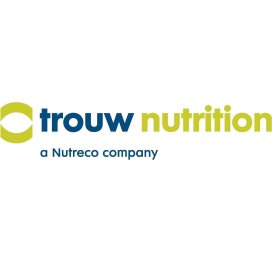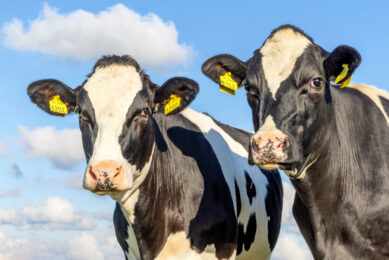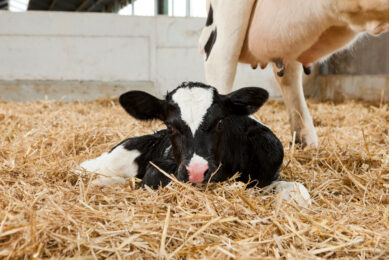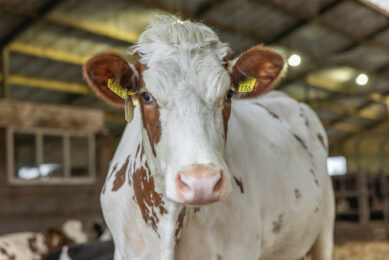3 practical ways to drive dairy efficiency and sustainability
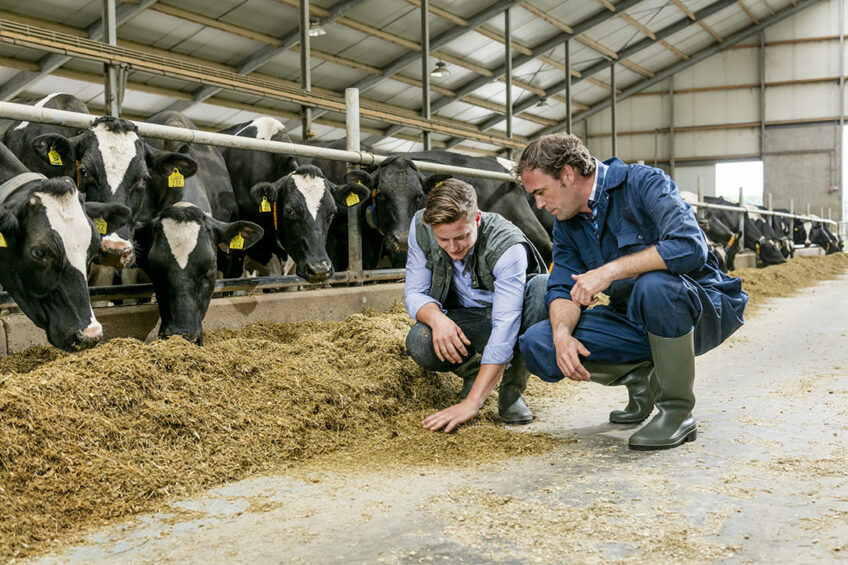
The efficiency of a dairy farm is affected by many factors and has a large impact on the carbon footprint of the farm. Three farm practices where big efficiency wins can be made are in calf rearing, transition cow health and feed management.
Milk production efficiency is highly correlated to both farm profitability and sustainability. Higher production efficiency of dairy cows leads to increased profitability of the farm and decreased carbon footprint per kilogram of milk produced (Figure 1).
Figure 1 – If milk production per cow goes up, the carbon footprint per kg milk drops.
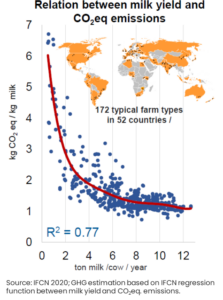
Placing a heightened focus on young calves’ nutrition, managing the transition period, and optimising feed efficiency can help minimise losses and boost herd productivity. Below, we will look at how these 3 efficiency-focused practices can drive improvements on the dairy farm.
Practice 1: Nourish the calves
Providing pre-weaned calves with a rich diet provides many benefits to the animal, the environment, and farm profitability. The first 12 weeks of a calf’s life has a big influence on her health, how quickly and efficiently she can be bred, how much milk she will eventually make, and even influences how many lactations she will have. These factors are the driving characteristics of how profitable this cow will be. To set your calf up for sustainable and profitable lifetime performance, you can focus on these 5 critical control points.
· Colostrum: Calves need to receive 3 to 4 litres of high-quality colostrum as soon after birth as possible, preferably within the first hour of life. An additional 2 litres within the first 6 hours and another 1 to 2 litres within the first 12 hours is recommended to fortify the calf’s immune system.
· Cleanliness: Keep the calving area and calf housing area clean and dry. Feeding equipment must be maintained with proper hygiene protocols.
· Comfort: Calves should be housed in a dry, bright, and well-ventilated environment with soft bedding.
· Calories: Provide calves with a rich diet for optimal immunity, growth, and future performance. Intensive feeding of a highly digestible calf milk replacer for the first 8 weeks of life followed by a stepdown weaning period of 2 to 4 weeks will deliver the plane of nutrition required to optimise performance.
· Consistency: Consistent feeding and cleaning schedules will improve calf performance, health, and welfare. Provide a high quality and consistent source of water, milk replacer, grain, and forage.
Practice 2: Enable a smooth transition
Following early life nutrition, the next impactful period of a cow’s life is the transition phase in which they move from the dry stage into lactation. This period will also have the largest impact on the cash flow of the farm. During this process, cows experience metabolic and physiological changes. Providing a digestible, nutritionally balanced diet and management practices that minimise metabolic stress enable dairy cows to make a smooth transition. Smooth transitions mean less labour to care for sick cows, higher levels of milk production, improved fertility, and a longer productive lifespan for the cow. Focus on these 4 areas to help your cows experience a smooth transition.
· Crowding: Overcrowding cows during the transition phase adds stress and reduces feed intake, two things that make for a rough transition. Provide your cows with at least 75 cm (30 in) of feed bunk space per cow. This guideline will give her the opportunity to eat and is very likely to give her enough space to lay down.
· Comfort: Effective cooling systems for warm months, good ventilation, and soft bedding will reduce the metabolic stress on your transition cow. Remember that the dry period is in the transition phase too.
· Cleanliness: The dairy cow’s immune system will be at its weakest during transition. A clean and dry housing and calving area will reduce the risk of infections such as metritis and mastitis.
· Control inflammation: Nutritional strategies and functional feed additives can reduce inflammation, particularly inflammation of the gastrointestinal tract. An inflammatory response in the gut can further suppress the cow’s immune system and increase the chance that she will get sick. Probiotics, prebiotics, and improved sources of zinc are some examples of functional products that can limit gut inflammation. Consult with your nutrition advisor and veterinarian to find the inflammation control strategies that are right for your farm.
Practice 3: Know what you are feeding the cow
Precision farming has improved the efficiency of crop production, delivering the necessary amount of inputs that the crop needs at the right time. The first step is monitoring the feed and forage components of what the cow will eat in order to formulate the right set of nutrients for the cow. Feed analysis is key to managing changes in the nutrient content of forages (Table 1).
Testing of fresh grass (see box), silage or other feed ingredients can be done at the dairy farm. With the use of mobile technology such as the NutriOpt On-site Adviser and the NutriOpt Mycotoxin Adviser, the dairy farmer or nutrition advisor can quickly detect when new ingredients fall below the specified quality thresholds in terms of nutritional content or mycotoxin level. Data from testing can be used to reformulate the ration and address a challenge potentially before feed intake, animal health, rumen function or fertility is affected. This brings a tailored approach to nutrition, ensuring that animals’ nutritional needs are met and not over-supplied.
Conclusion
Improving the milk production efficiency of your herd will increase the profitability of the farm while at the same time reducing the environmental footprint of the milk that you produce. 3 critical areas where you can increase efficiency are by nourishing your calves, enable a smooth transition for your cows around calving, and by measuring and monitoring what your cows are eating. These actions will contribute to your farm’s profitability and environmental sustainability efforts.
References are available on request.
Join 13,000+ subscribers
Subscribe to our newsletter to stay updated about all the need-to-know content in the dairy sector, two times a week.


